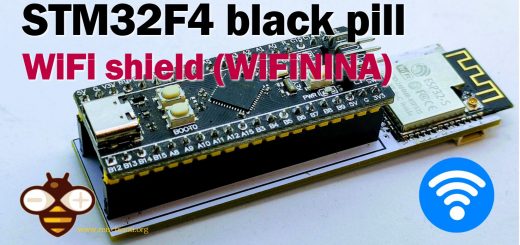Home › Forums › The libraries hosted on the site › EByte LoRa e220 UART devices LLCC68 › Send struct data
Tagged: structured data
- This topic has 11 replies, 3 voices, and was last updated 2 years, 6 months ago by
Renzo Mischianti.
-
AuthorPosts
-
-
25 February 2023 at 18:01 #24353
Good morning,
I have a projet of connected beehive. I want to follow the weight, the temperature and the humidity.
I use several sensors and I need to send data using 2 E220-400T30D Ebyte modules.
I can send a single value (for example the weight). I use the different examples in the librairy.
But I can’t send all the value with an array.Here is a part of my sender header :
#define ENABLE_RSSI true #define RUCHER "Ruche1" struct Message { char ruche[10]; //ruche = beehive in english float poids; //poids= weight in english };and in sender void loop
for (float poids=0; poids<100; poids++) //for the test, I increase manually the variable poids to simulate a weight variation. In reality the weight will come from a sensor. { struct Message msg = {RUCHER, poids}; // for the test I only try to send the name of my beehive "Ruche1" and the weight poids // Send message ResponseStatus rs = e220ttl.sendFixedMessage(0, 3, 23, &msg, sizeof(Message)); // Check If there is some problem of succesfully send // Print the data send Serial.print("Message Array length : ");Serial.println(sizeof(msg.ruche)); Serial.println(msg.ruche); Serial.print("Poids Array length : ");Serial.println(sizeof(msg.poids)); Serial.println(msg.poids); Serial.println(rs.getResponseDescription()); Serial.println(sizeof(Message)); delay(10000); }For the receiver, the header is the same
In receiver void loop I have the following code :// Print the data received Serial.println(rsc.status.getResponseDescription()); struct Message msg = *(Message*) rsc.data; Serial.println(msg.ruche); Serial.println(msg.poids); Serial.println(sizeof(Message)); rsc.close();And the result shown in serial monitor for the sender :
Message Array length : 10 Ruche1 Poids Array length : 4 2.00 Success 14but in serial monitor for the receiver I have :
Message received! <——– my message is received Success <——– success in transmission <——– nothing but should be Ruche1 0.00 <——– 0.00 but should be 2.00 14I don’t understand why the value are not correctly received…
Is someone could help me please ?Thank you very much
Damien
-
26 February 2023 at 09:37 #24355
Good morning,
maybe an idea. It seems to work properly when RSSI is disabled.
Is there a specfic wiring when RSSI is enabled ?Regards
Damien
-
27 February 2023 at 10:56 #24358
Hi,
for this first problem, I think It’s a wrong initialization of structure.
Use a string with 10 characters and retry.
Bye RM
-
-
26 February 2023 at 11:06 #24356
Good morning,
other point, when I try to set configuration, I have the following message :
No response from device! (Check wiring)
12What I don’t understand is I can send and receive structured data when I disabled RSSI in my program. But I think the problem could come from configuration settings.
My wiring is normal (M0 and M1 to GND, Aux Pullup with 4,7kohm, TX to Pin 2 of arduino uno with a 4,7kohm between 3,3V and the pin, RX connected to pin 3 of arduino uno with the 1kohm resistance (voltage divider).I strictly respect the Standard configuration (Transparent) wiring.
When I use the examples (02_SendTransparentTransmission and 07_receiveMessages) i can send and receive structured data, it works fine, I can modify the program to adjust what I want to send. Everything is OK.
So I think the problem comes from the configuration settings that I can’t modify.How is it possible to have a message “No response from device! (Check wiring)” when I try to set configuration whereas I can communicate between my 2 arduinos with E220 which confirms my wiring is correct ?
Regards
Damien
-
26 February 2023 at 12:06 #24357
Good morning,
I tried with the fully connected shema to be able to set up configuration options.
There is stil the message “No response from device! (Check wiring)”.It prints a configuration even if there is no response from the device.
What is completely strange is when I send different programs in my arduino and between each transfer I use the GetConfiguration program I have different results whereas I don’t change the configuration. Example :
No response from device! (Check wiring) 12 —————————————- HEAD : AE 2 76 AddH : D2 AddL : 81 Chan : 205 -> 615MHz SpeedParityBit : 0 -> 8N1 (Default) SpeedUARTDatte : 0 -> 1200bps SpeedAirDataRate : 0 -> 2.4kbps OptionSubPacketSett: 0 -> 200bytes (default) OptionTranPower : 0 -> 22dBm (Default) OptionRSSIAmbientNo: 0 -> Disabled (default) TransModeWORPeriod : 10 -> 1500ms TransModeEnableLBT : 0 -> Disabled (default) TransModeEnableRSSI: 0 -> Disabled (default) TransModeFixedTrans: 0 -> Transparent transmission (default) —————————————- No response from device! (Check wiring) 12 —————————————- HEAD: 0 0 97 Model no.: 6E Version : 73 Features : 70 —————————————- Then —————————————- HEAD : 28 43 68 AddH : 65 AddL : 63 Chan : 119 -> 529MHz SpeedParityBit : 1 -> 8O1 SpeedUARTDatte : 11 -> 9600bps (default) SpeedAirDataRate : 11 -> 4.8kbps OptionSubPacketSett: 0 -> 200bytes (default) OptionTranPower : 0 -> 30dBm (Default) OptionRSSIAmbientNo: 1 -> Enabled TransModeWORPeriod : 1 -> 1000ms TransModeEnableLBT : 0 -> Disabled (default) TransModeEnableRSSI: 0 -> Disabled (default) TransModeFixedTrans: 1 -> Fixed transmission (first three bytes can be used as high/low address and channel) —————————————- No response from device! (Check wiring) and after No response from device! (Check wiring) 12 —————————————- HEAD : 0 0 74 AddH : 7C AddL : DC Chan : 205 -> 615MHz SpeedParityBit : 0 -> 8N1 (Default) SpeedUARTDatte : 0 -> 1200bps SpeedAirDataRate : 0 -> 2.4kbps OptionSubPacketSett: 0 -> 200bytes (default) OptionTranPower : 0 -> 22dBm (Default) OptionRSSIAmbientNo: 0 -> Disabled (default) TransModeWORPeriod : 10 -> 1500ms TransModeEnableLBT : 0 -> Disabled (default) TransModeEnableRSSI: 0 -> Disabled (default) TransModeFixedTrans: 0 -> Transparent transmission (default) —————————————- No response from device! (Check wiring) 12 —————————————- HEAD: 0 0 97 Model no.: 6E Version : 73 Features : 70 —————————————-How this can be possible ????
Regards
Damien
-
27 February 2023 at 10:57 #24359
For the last problem, I think It can be a power supply problem or wrong wiring, or a fired LoRa device.
But you must try to change something to find the correct solution.
Bye Renzo-
20 March 2023 at 03:46 #24862
Hi Renzo
I had a similar problem and I think I found the source of the bug.
The bug occurs when using aStringtype variable for the message. The Sender does not send the last character of the String.
Ex: When sending “101”, the Sender sends “10”, that is, it does not send the last character.
Ex:static int msg = 100; msg++; String msg_sent = String(msg); Serial.print("Sent Message: "); Serial.println(msg_sent); ResponseStatus rs = e220ttl.sendMessage(msg_sent);I think the bug is on line 831:
LoRa_E220.cpp#L831At the moment:
byte size = message.length(); // sizeof(message.c_str())+1;I changed it to:
byte size = message.length() + 1; // sizeof(message.c_str())+1;Everything worked fine.
There are other parts of the code that may need fixing. (I haven’t tested yet)
Ex:Line 850:
LoRa_E220.cpp#L850ResponseStatus LoRa_E220::sendFixedMessage(byte ADDH, byte ADDL, byte CHAN, const String message){ byte size = message.length(); // sizeof(message.c_str())+1; -
20 March 2023 at 03:55 #24863
OBS: I am using RSSI Enabled
#define ENABLE_RSSI true -
21 March 2023 at 07:54 #24877
Thanks George for your information, I will try to retest the specific case soon.
Thanks again Renzo -
24 March 2023 at 08:42 #24892
Hi George,
I did some test, and the library work correctly, I think you don’t do the correct configuration on the booth device. To send and receive the RSSI, you must set the RSSI parameter on the boot deviceconfiguration.TRANSMISSION_MODE.enableRSSI = RSSI_ENABLED;Use the precompiled configuration for sender and receiver that you can find in the examples.
Bye Renzo
-
-
27 February 2023 at 19:31 #24497
Hi,
thank you for the responses.
When I wire directly M0 and M1 to the 3.3V, I’m able to set configuration and activate RSSI.
I will try again with the fully connected shema, but at least, I know I can set configuration.I have another question to configure the power to 30dbm.
I put #define E220_30 in header
But when I try to put POWER_30 rather than POWER_22 in parameters, it doesn’t recognize POWER_30.An idea ?
-
21 March 2023 at 08:08 #24879
Hi,
you must set the correct frequency.Ebyte LoRa E220 LLCC68 device for Arduino, esp32 or esp8266: library – 2
Bye Renzo
-
-
-
AuthorPosts
- You must be logged in to reply to this topic.






